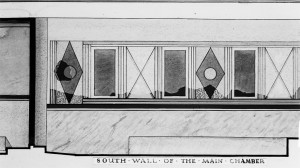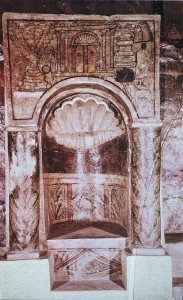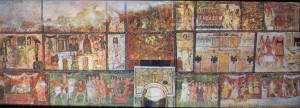What Was the Art in the Synagogue at Dura Europos Made of
In its first, the synagogue of Dura-Europos was a very sober identify with none of the excellent decorations that fabricated it and so famous worldwide through the centuries. The earthworks report offers interesting details nearly the synagogue edifice prior the great renovation of the years 244/245 CE.
The decoration of the early synagogue was conventional and plain, characterized by geometric forms and color schemes.

Before building, reconstruction of wall decoration (Yale Univ. Art Gallery)
The ceiling was painted in simulated of a coffered ceiling with bright colors, including red and blue. With the renovation of the construction of the edifice, the decoration of the walls in the Firm of Assembly changed as well. The walls were painted from the ceiling to the dado with beautiful, colored paintings located on three structural elements: ceiling, walls and Torah shrine.

Torah shrine with the paintings; starting time stage decorations of the earlier building (Univ. of California, San Diego)
The walls were about seven meters loftier. Based on current knowledge, such a big diverseness of paintings cannot exist found in other surviving synagogues of the same or later periods. The quantity of paintings remaining, 60% of the total, "exceeded that of any comparable structure in the entire city" (Kraeling 1956, 39), such as the Mithraeum, the Christian building and the Temple of Bel. Kraeling subdivides the wall paintings into five zones, starting from the uppermost zone, the so-called "outset register," which is lost, up to the dado. A second zone (Register A), third and 4th zones (Registers B and C) follow. The fifth zone was the dado close to the benches with imitation marble and representations of animals and masks.
The embankment built past the Romans preserved near of the paintings only not the highest portion of the wall, causing the loss of the decorations. This happened to the near of the southern and eastern walls, where but some paintings from the lower annals are left and to the upper function of the northern wall. The western wall was oriented towards Jerusalem and hosted the Torah shrine. It is the best preserved wall. This text uses Kraeling'due south classification according the diagrams of the excavation report: W=Due west wall, Registers A, B, C; North=Northern wall, Registers A, B, C, etc. Paintings close to the Torah shrine in the western wall are called "wing panels." Contrary to the frequent mention of "frescoes," Clark importantly notes that: "The paintings at Dura are not frescoes with the colors embedded in the plaster simply made in tempera and and then easily blurred if incautiously rubbed."1 As a consequence, they faded quickly when they were exposed to the light later their discovery.

Diagram of western wall (Yale Univ. Fine art Gallery)
The surviving paintings represent some of the most important stories from the Jewish Bible, including special translations, Midrashic and Haggadic materials. The quantity of writings and publications about the paintings is large and at that place is barely a topic that has not been discussed. The western wall'south paintings have been studied profusely because of their prominent position on the wall where the Torah shrine was located and also because they were in front of the main entrance and were the commencement seen by visitors. To modern viewers, they offering the reward of being well preserved.

Western wall paintings (Yale Univ. Art Gallery)
While on the southern and the eastern walls but parts of the lower registers are left, on the northern wall a complex painting was preserved, identified by Kraeling equally "Ezekiel, the Devastation and Restoration of National Life" and by Wischnitzer equally "Ezekiel's Vision of the Resurrection of the Dry Basic."2

Ezekiel panel,"The Devastation and Restoration of National Life." NC i Section A (Yale Univ. Art Gallery)
Source: https://chayacassano.commons.gc.cuny.edu/iconography/
0 Response to "What Was the Art in the Synagogue at Dura Europos Made of"
Post a Comment